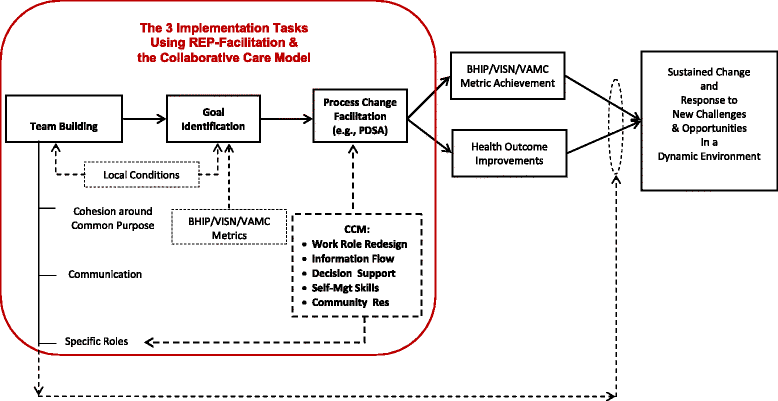Partnering with health system operations leadership to develop a controlled implementation trial
- PMID: 26912342
- PMCID: PMC4765154
- DOI: 10.1186/s13012-016-0385-7
Partnering with health system operations leadership to develop a controlled implementation trial
Abstract
Background: Outcome for mental health conditions is suboptimal, and care is fragmented. Evidence from controlled trials indicates that collaborative chronic care models (CCMs) can improve outcomes in a broad array of mental health conditions. US Department of Veterans Affairs leadership launched a nationwide initiative to establish multidisciplinary teams in general mental health clinics in all medical centers. As part of this effort, leadership partnered with implementation researchers to develop a program evaluation protocol to provide rigorous scientific data to address two implementation questions: (1) Can evidence-based CCMs be successfully implemented using existing staff in general mental health clinics supported by internal and external implementation facilitation? (2) What is the impact of CCM implementation efforts on patient health status and perceptions of care?
Methods/design: Health system operation leaders and researchers partnered in an iterative process to design a protocol that balances operational priorities, scientific rigor, and feasibility. Joint design decisions addressed identification of study sites, patient population of interest, intervention design, and outcome assessment and analysis. Nine sites have been enrolled in the intervention-implementation hybrid type III stepped-wedge design. Using balanced randomization, sites have been assigned to receive implementation support in one of three waves beginning at 4-month intervals, with support lasting 12 months. Implementation support consists of US Center for Disease Control's Replicating Effective Programs strategy supplemented by external and internal implementation facilitation support and is compared to dissemination of materials plus technical assistance conference calls. Formative evaluation focuses on the recipients, context, innovation, and facilitation process. Summative evaluation combines quantitative and qualitative outcomes. Quantitative CCM fidelity measures (at the site level) plus health outcome measures (at the patient level; n = 765) are collected in a repeated measures design and analyzed with general linear modeling. Qualitative data from provider interviews at baseline and 1 year elaborate CCM fidelity data and provide insights into barriers and facilitators of implementation.
Discussion: Conducting a jointly designed, highly controlled protocol in the context of health system operational priorities increases the likelihood that time-sensitive questions of operational importance will be answered rigorously and that the outcomes will result in sustainable change in the health-care system.
Trial registration: NCT02543840 ( https://www.clinicaltrials.gov/ct2/show/NCT02543840).
Figures



References
-
- Watkins KE, Pincus HA, Paddock S, Smith B, Woodroffe A, Farmer C, et al. Care for veterans with mental and substance use disorders: good performance, but room to improve on many measures. Health Aff. 2011;30:2194–203. - PubMed
Publication types
MeSH terms
Associated data
LinkOut - more resources
Full Text Sources
Other Literature Sources
Medical
Research Materials

